DouglasHoover
Douglas Hoover
How To Build The Perfect Koi Pond- Liner or Concrete- DIY
Prior to retiring, after 30 years of designing, engineering and building well over 2000 water features, if there is one definite thing I have learned, it is that a water garden can be the most enjoyable investment you could ever make, or the biggest nightmare. A few years back I received a call from an angry water garden owner. What she began describing to me was anything but an ideal water garden experience.
She began by telling me the pond was leaking, and she needed to add water daily. Her pond was full of algae and smelled like dead fish. Besides the need to pull the sump pump out of the pond every three days to clean the algae and debris from its intake screen, her electric bill had almost doubled since she installed the pond. She continued, "The grand kids were climbing around on the waterfall and the rocks slid around, exposing the liner everywhere and it looked horrible."
When she complained to the contractor about the need to add water every couple of days, he came out and did something and it stopped losing water. She went on to explain that she told a friend her water bill was three times its normal cost and that she heard running water all the time, and thought it might be a stuck toilet tank float. The friend investigated and discovered the contractor had installed a mechanical water level controller to the pond. He had decided it would be far easier than finding and fixing the leak, apparently assuming that the client would never figure it out.
Then came the dreaded question she asked me: "Can you help me out?" My automatic response was, "How much did you spend on your pond and waterfall?" She choked out, "$6,500!" I then asked, did the contractor warn her of the negative aspects of a liner pond, such as dangers from gnawing rodents, tree root punctures, sharp rocks, and other such objects? Her response was, "No, not a thing."
I explained that I do not attempt patching or correcting other contractors' mistakes. Even if a leak was found, you could not be sure it was the only one unless the entire waterfall and pond were disassembled. She was very angry and wanted to know what recourse she had. I explained that dozen of my clients, in similar situations, used small claims court to recover their losses from unscrupulous contractors. All of them were successful in court, since none of their contractors had mentioned the various flaws associated with liner construction.
Follow these six suggestions for designing a trouble-free and long lasting water feature:
1. Research every aspect of water gardening before you start. You will rarely get unbiased information from pond liner advocates that sell pond liner kits and sump pumps. Most liner advocates malign concrete pond construction in order to promote their pond liners and equipment since it is more profitable, easier and quicker to install.
2. Find a qualified licensed contractor with insurance, bonding, workers comp and water garden construction experience.
3. Build the water garden, pond and waterfall using rebar and concrete. It will last for decades. The pond liner track record speaks for itself:
4. Use an energy-efficient centrifugal pump. Sump pumps are not designed for continuous operation, only intermittent duty. In addition, they have limited warranties and use up to 60% more energy than centrifugal pumps. Install two anti-vortex suction drains in the bottom of the pond.
5. Install a back-flushable bead bio-filter which eliminates 90% of the pond maintenance and a UV sterilizer which kills pathogens and planktonic algae that turns water green.
6. Install an aquafill water level controller and you will not need to ever add water manually with a hose, taking a risk that you may some day start adding water, get distracted, walk away and forget it, causing an overflow plus risking the chance you may kill your fish from chlorine poisoning.
A water garden should not be considered a short term investment. Water gardens in most cases will bring more long term joy and pleasure than anything someone could spend money on. It is something that should last for decades. If it is built with concrete and rebar, it is built to last. Liner construction, however, does not last. Take it from a professional. If it is not worth doing right, then it is not worth doing at all. Google: Liner vs Concrete for more information on differences, between these to types of construction.

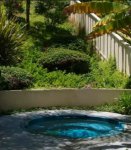
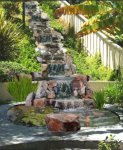
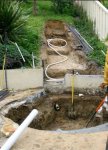
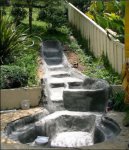
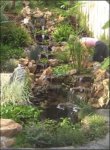





Prior to retiring, after 30 years of designing, engineering and building well over 2000 water features, if there is one definite thing I have learned, it is that a water garden can be the most enjoyable investment you could ever make, or the biggest nightmare. A few years back I received a call from an angry water garden owner. What she began describing to me was anything but an ideal water garden experience.
She began by telling me the pond was leaking, and she needed to add water daily. Her pond was full of algae and smelled like dead fish. Besides the need to pull the sump pump out of the pond every three days to clean the algae and debris from its intake screen, her electric bill had almost doubled since she installed the pond. She continued, "The grand kids were climbing around on the waterfall and the rocks slid around, exposing the liner everywhere and it looked horrible."
When she complained to the contractor about the need to add water every couple of days, he came out and did something and it stopped losing water. She went on to explain that she told a friend her water bill was three times its normal cost and that she heard running water all the time, and thought it might be a stuck toilet tank float. The friend investigated and discovered the contractor had installed a mechanical water level controller to the pond. He had decided it would be far easier than finding and fixing the leak, apparently assuming that the client would never figure it out.
Then came the dreaded question she asked me: "Can you help me out?" My automatic response was, "How much did you spend on your pond and waterfall?" She choked out, "$6,500!" I then asked, did the contractor warn her of the negative aspects of a liner pond, such as dangers from gnawing rodents, tree root punctures, sharp rocks, and other such objects? Her response was, "No, not a thing."
I explained that I do not attempt patching or correcting other contractors' mistakes. Even if a leak was found, you could not be sure it was the only one unless the entire waterfall and pond were disassembled. She was very angry and wanted to know what recourse she had. I explained that dozen of my clients, in similar situations, used small claims court to recover their losses from unscrupulous contractors. All of them were successful in court, since none of their contractors had mentioned the various flaws associated with liner construction.
Follow these six suggestions for designing a trouble-free and long lasting water feature:
1. Research every aspect of water gardening before you start. You will rarely get unbiased information from pond liner advocates that sell pond liner kits and sump pumps. Most liner advocates malign concrete pond construction in order to promote their pond liners and equipment since it is more profitable, easier and quicker to install.
2. Find a qualified licensed contractor with insurance, bonding, workers comp and water garden construction experience.
3. Build the water garden, pond and waterfall using rebar and concrete. It will last for decades. The pond liner track record speaks for itself:
More than 37% of all waterfalls have serious structural damage within 3 years of construction.
57% of homeowners say they are rather unsatisfied with the way their waterfall came out after the project was completed.
One in three waterfalls and ponds are leaking water within nine months of completion.
63% of "do-it-yourselfers" say they wished they had the proper information from the "get go" or that they had hired someone.
4. Use an energy-efficient centrifugal pump. Sump pumps are not designed for continuous operation, only intermittent duty. In addition, they have limited warranties and use up to 60% more energy than centrifugal pumps. Install two anti-vortex suction drains in the bottom of the pond.
5. Install a back-flushable bead bio-filter which eliminates 90% of the pond maintenance and a UV sterilizer which kills pathogens and planktonic algae that turns water green.
6. Install an aquafill water level controller and you will not need to ever add water manually with a hose, taking a risk that you may some day start adding water, get distracted, walk away and forget it, causing an overflow plus risking the chance you may kill your fish from chlorine poisoning.
A water garden should not be considered a short term investment. Water gardens in most cases will bring more long term joy and pleasure than anything someone could spend money on. It is something that should last for decades. If it is built with concrete and rebar, it is built to last. Liner construction, however, does not last. Take it from a professional. If it is not worth doing right, then it is not worth doing at all. Google: Liner vs Concrete for more information on differences, between these to types of construction.












